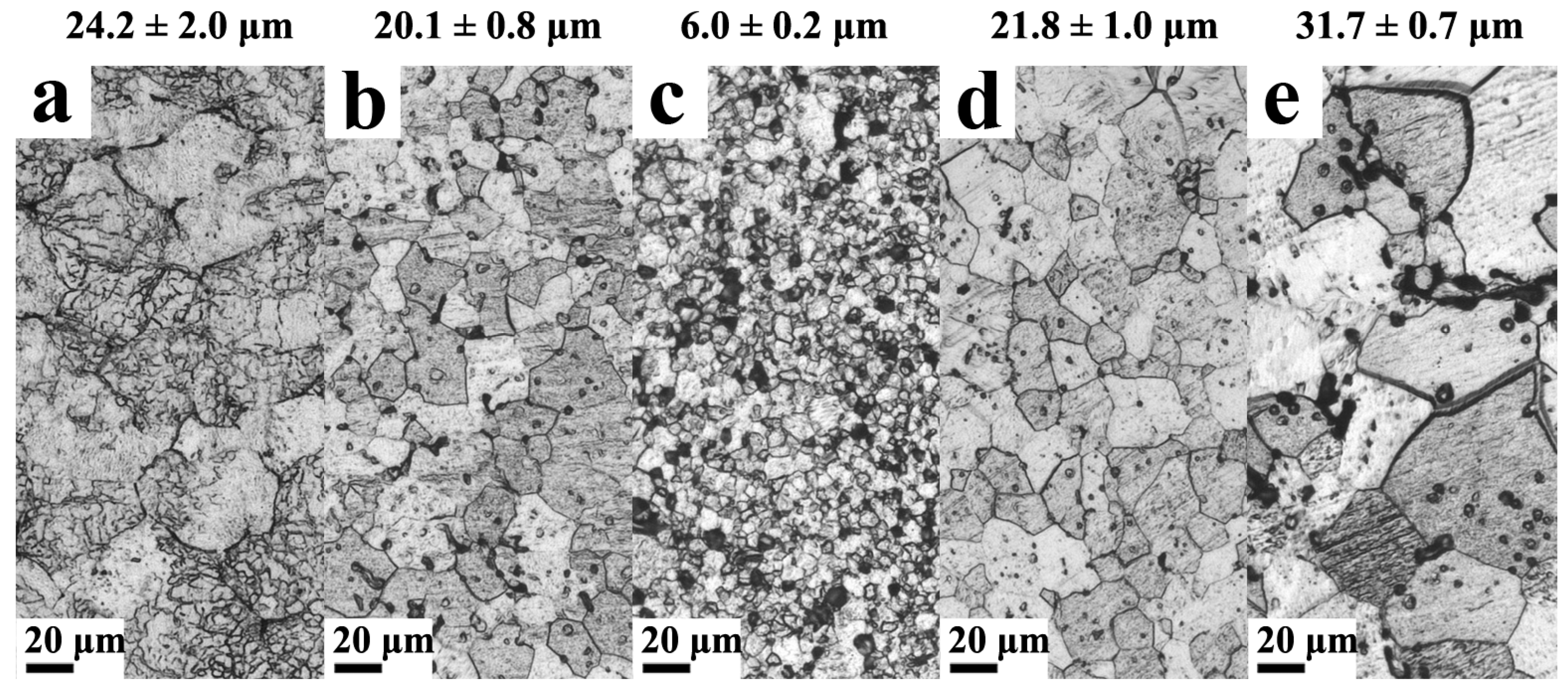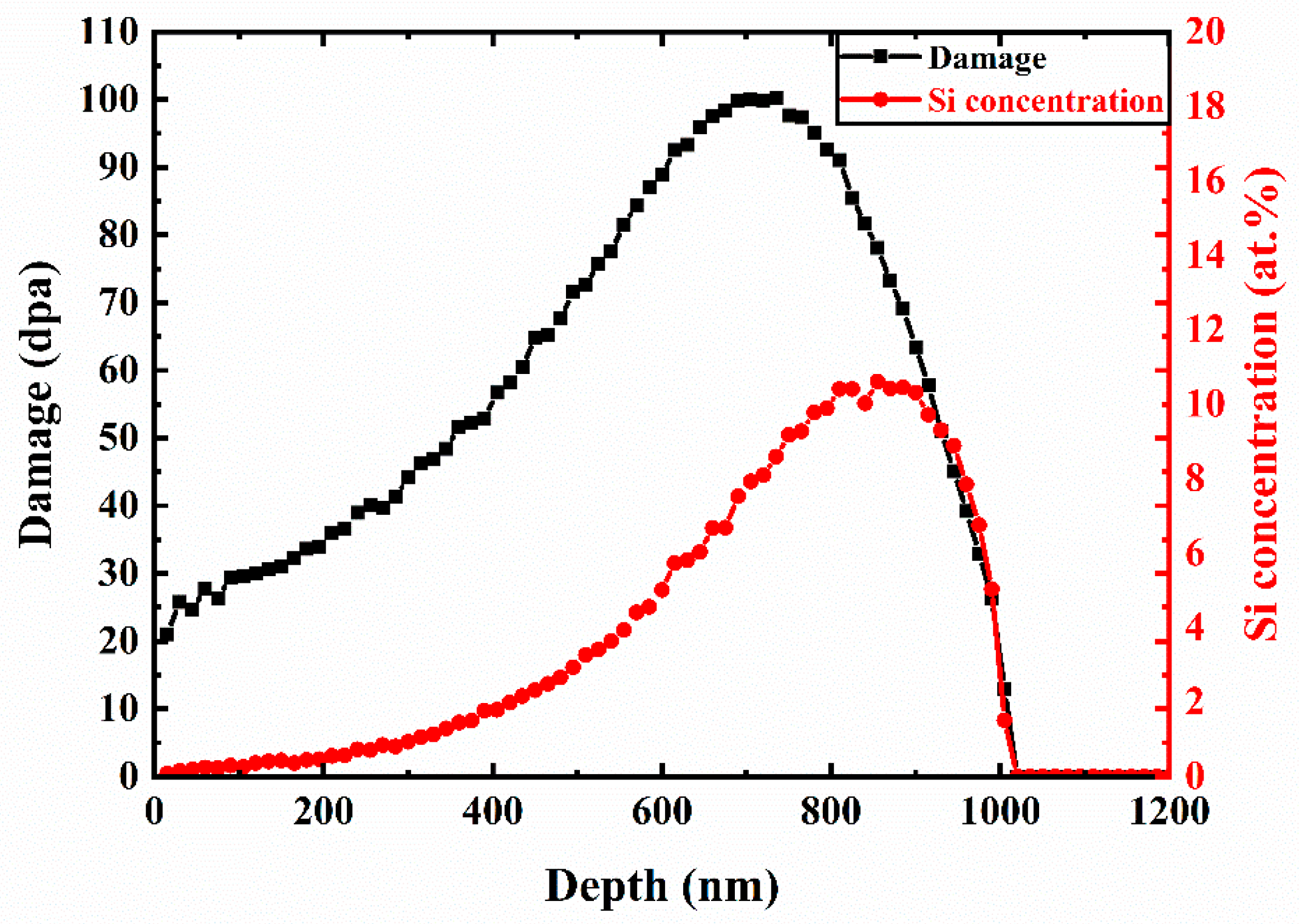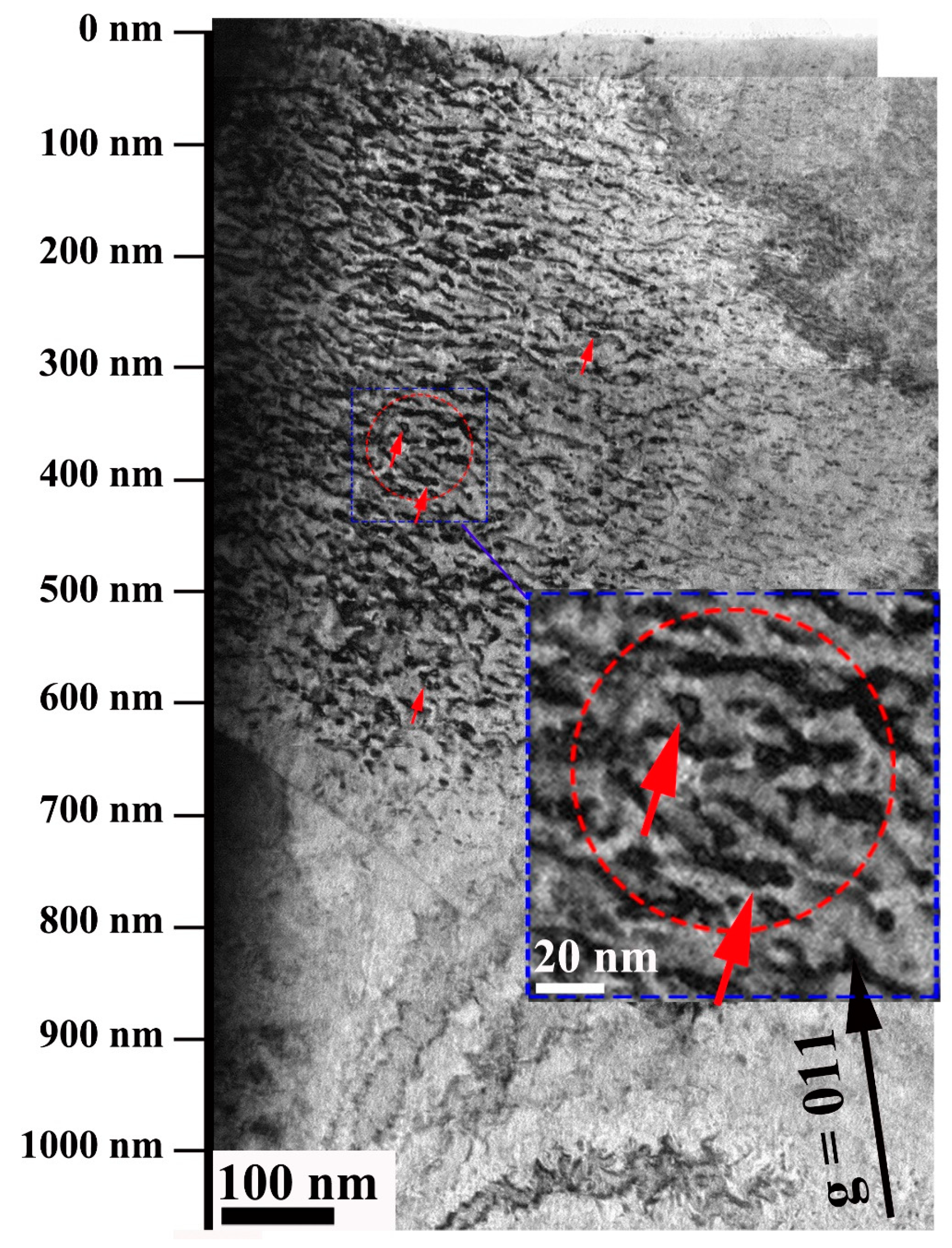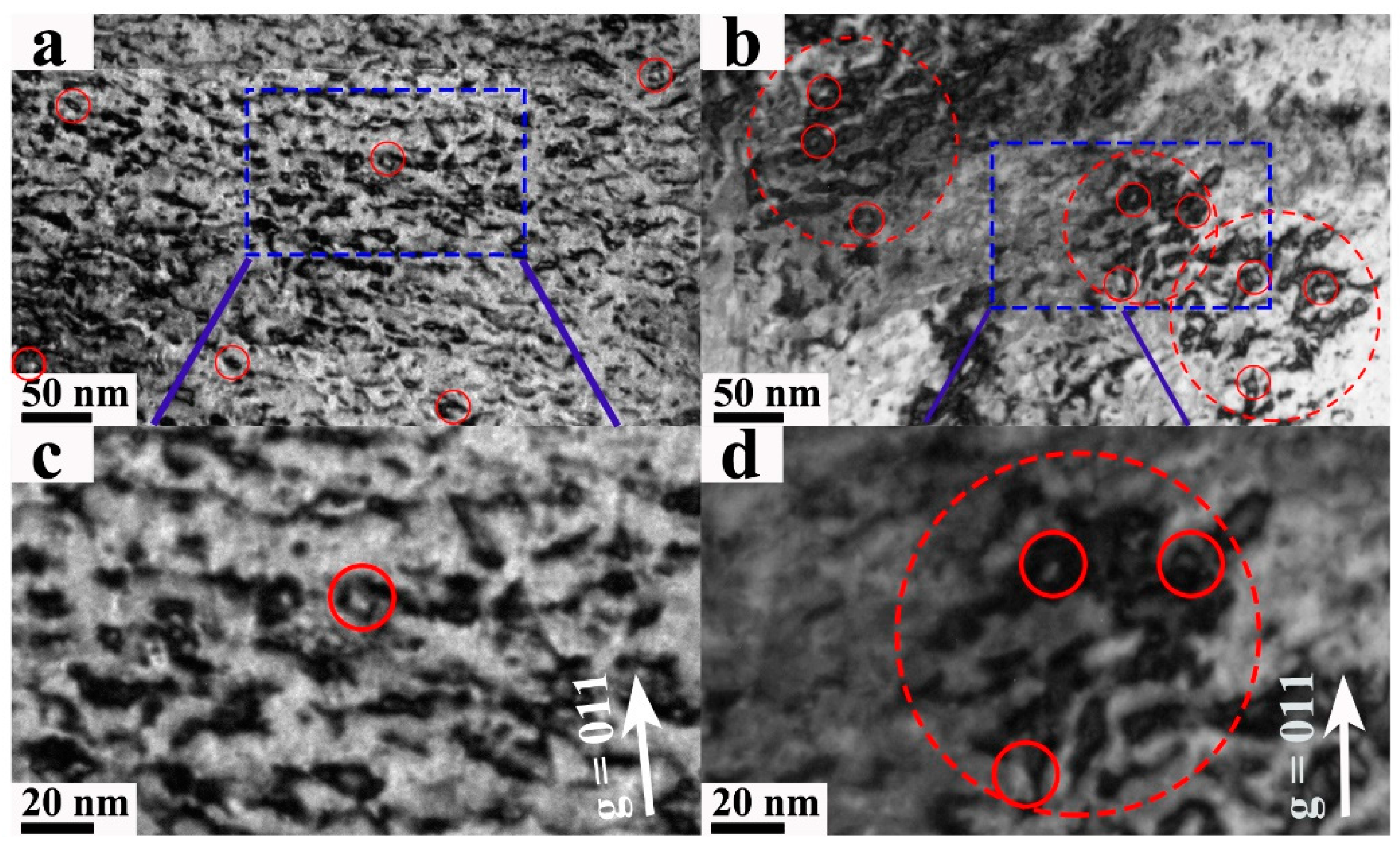The Effect of Rhenium Content on Microstructural Changes and Irradiated Hardening in W-Re Alloy under High-Dose Ion Irradiation
Abstract
1. Introduction
2. Materials and Methods
3. Results
3.1. Microstructure
3.1.1. Surface Topography
3.1.2. Dislocation Loops
3.1.3. Voids
3.2. Nano-Indentation Test
4. Discussion
4.1. Effect of Re Content on Grain Size
4.2. Effect of Re Content on Microstructure
4.3. Effect of Re Content on Hardness under High-Dose Irradiation
5. Conclusions
Author Contributions
Funding
Data Availability Statement
Acknowledgments
Conflicts of Interest
References
- Barrett, T.R.; Ellwood, G.; Pérez, G.; Kovari, M.; Fursdon, M.; Domptail, F.; Kirk, S.; McIntosh, S.C.; Roberts, S.; Zheng, S.; et al. Progress in the Engineering Design and Assessment of the European DEMO First Wall and Divertor Plasma Facing Components. Fusion Eng. Des. 2016, 109–111, 917–924. [Google Scholar] [CrossRef]
- You, J.H.; Visca, E.; Barrett, T.; Böswirth, B.; Crescenzi, F.; Domptail, F.; Fursdon, M.; Gallay, F.; Ghidersa, B.E.; Greuner, H.; et al. European Divertor Target Concepts for DEMO: Design Rationales and High Heat Flux Performance. Nucl. Mater. Energy 2018, 16, 1–11. [Google Scholar] [CrossRef]
- Qiu, G.; Zhan, D.; Li, C.; Qi, M.; Yang, Y.; Jiang, Z.; Zhang, H. Effects of Yttrium on Microstructure Stability and Tensile Properties of China Low Activation Martensitic Steel. Metals 2019, 9, 446. [Google Scholar] [CrossRef]
- Muroga, T.; Chen, J.M.; Chernov, V.M.; Kurtz, R.J.; Le Flem, M. Present Status of Vanadium Alloys for Fusion Applications. J. Nucl. Mater. 2014, 455, 263–268. [Google Scholar] [CrossRef]
- Katoh, Y.; Snead, L.L.; Henager, C.H.; Nozawa, T.; Hinoki, T.; Iveković, A.; Novak, S.; Gonzalez De Vicente, S.M. Current Status and Recent Research Achievements in SiC/SiC Composites. J. Nucl. Mater. 2014, 455, 387–397. [Google Scholar] [CrossRef]
- Kashkarov, E.; Nikitenkov, N.; Sutygina, A.; Laptev, R.; Bordulev, Y.; Obrosov, A.; Liedke, M.O.; Wagner, A.; Zak, A.; Weiβ, S. Microstructure, Defect Structure and Hydrogen Trapping in Zirconium Alloy Zr-1Nb Treated by Plasma Immersion Ti Ion Implantation and Deposition. J. Alloys Compd. 2018, 732, 80–87. [Google Scholar] [CrossRef]
- Liu, D.G.; Zheng, L.; Luo, L.M.; Zan, X.; Song, J.P.; Xu, Q.; Zhu, X.Y.; Wu, Y.C. An Overview of Oxidation-Resistant Tungsten Alloys for Nuclear Fusion. J. Alloys Compd. 2018, 765, 299–312. [Google Scholar] [CrossRef]
- Lin, J.S.; Hao, Y.C.; Luo, L.M.; Zhao, M.L.; Xu, Q.; Zan, X.; Zhu, X.Y.; Wu, Y.C. Microstructure and Performances of W–TiC–Y2O3 Composites Prepared by Mechano-Chemical and Wet-Chemical Methods. J. Alloys Compd. 2018, 732, 871–879. [Google Scholar] [CrossRef]
- Pitts, R.A.; Carpentier, S.; Escourbiac, F.; Hirai, T.; Komarov, V.; Kukushkin, A.S.; Lisgo, S.; Loarte, A.; Merola, M.; Mitteau, R.; et al. Physics Basis and Design of the ITER Plasma-Facing Components. J. Nucl. Mater. 2011, 415, 957–964. [Google Scholar] [CrossRef]
- Yu, P.F.; Pan, B.C. Performance of Tungsten Nitride Compound Surfaces to Resist Sputtering under Intense Irradiation in Nuclear Fusion Reactors. Appl. Surf. Sci. 2022, 600, 32–34. [Google Scholar] [CrossRef]
- Tanno, T.; Hasegawa, A.; Fujiwara, M.; He, J.C.; Nogami, S.; Satou, M.; Shishido, T.; Abe, K. Precipitation of Solid Transmutation Elements in Irradiated Tungsten Alloys. Mater. Trans. 2008, 49, 2259–2264. [Google Scholar] [CrossRef]
- Cottrell, G.A.; Pampin, R.; Taylor, N.P. Transmutation and Phase Stability of Tungsten Armor in Fusion Power Plants. Fusion Sci. Technol. 2006, 50, 89–98. [Google Scholar] [CrossRef]
- Terentyev, D.; Yin, C.; Dubinko, A.; Chang, C.C.; You, J.H. Neutron Irradiation Hardening across ITER Diverter Tungsten Armor. Int. J. Refract. Met. Hard Mater. 2021, 95, 105437. [Google Scholar] [CrossRef]
- Gilbert, M.R.; Sublet, J.C. Neutron-Induced Transmutation Effects in W and W-Alloys in a Fusion Environment. Nucl. Fusion 2011, 51, 043005. [Google Scholar] [CrossRef]
- Knaster, J.; Moeslang, A.; Muroga, T. Materials Research for Fusion. Nat. Phys. 2016, 12, 424–434. [Google Scholar] [CrossRef]
- Fukuda, M.; Yabuuchi, K.; Nogami, S.; Hasegawa, A.; Tanaka, T. Microstructural Development of Tungsten and Tungsten-Rhenium Alloys Due to Neutron Irradiation in HFIR. J. Nucl. Mater. 2014, 455, 460–463. [Google Scholar] [CrossRef]
- Hasegawa, A.; Fukuda, M.; Nogami, S.; Yabuuchi, K. Neutron Irradiation Effects on Tungsten Materials. Fusion Eng. Des. 2014, 89, 1568–1572. [Google Scholar] [CrossRef]
- Armstrong, D.E.J.; Yi, X.; Marquis, E.A.; Roberts, S.G. Hardening of Self Ion Implanted Tungsten and Tungsten 5-Wt% Rhenium. J. Nucl. Mater. 2013, 432, 428–436. [Google Scholar] [CrossRef]
- Yamamoto, T.; Hara, M.; Hatano, Y. Cracking Behavior and Microstructural, Mechanical and Thermal Characteristics of Tungsten–Rhenium Binary Alloys Fabricated by Laser Powder Bed Fusion. Int. J. Refract. Met. Hard Mater. 2021, 100, 105651. [Google Scholar] [CrossRef]
- Xu, A.; Armstrong, D.E.J.; Beck, C.; Moody, M.P.; Smith, G.D.W.; Bagot, P.A.J.; Roberts, S.G. Ion-Irradiation Induced Clustering in W-Re-Ta, W-Re and W-Ta Alloys: An Atom Probe Tomography and Nanoindentation Study. Acta Mater. 2017, 124, 71–78. [Google Scholar] [CrossRef]
- Nogami, S.; Terentyev, D.; Zinovev, A.; Yin, C.; Rieth, M.; Pintsuk, G.; Hasegawa, A. Neutron Irradiation Tolerance of Potassium-Doped and Rhenium-Alloyed Tungsten. J. Nucl. Mater. 2021, 553, 153009. [Google Scholar] [CrossRef]
- Yi, X.; Jenkins, M.L.; Kirk, M.A.; Zhou, Z.; Roberts, S.G. In-Situ TEM Studies of 150 KeV W+ Ion Irradiated W and W-Alloys: Damage Production and Microstructural Evolution. Acta Mater. 2016, 112, 105–120. [Google Scholar] [CrossRef]
- Hwang, T.; Fukuda, M.; Nogami, S.; Hasegawa, A.; Usami, H.; Yabuuchi, K.; Ozawa, K.; Tanigawa, H. Effect of Self-Ion Irradiation on Hardening and Microstructure of Tungsten. Nucl. Mater. Energy 2016, 9, 430–435. [Google Scholar] [CrossRef]
- Hwang, T.; Hasegawa, A.; Tomura, K.; Ebisawa, N.; Toyama, T.; Nagai, Y.; Fukuda, M.; Miyazawa, T.; Tanaka, T.; Nogami, S. Effect of Neutron Irradiation on Rhenium Cluster Formation in Tungsten and Tungsten-Rhenium Alloys. J. Nucl. Mater. 2018, 507, 78–86. [Google Scholar] [CrossRef]
- Jiang, W.; Zhu, Y.; Zhang, L.; Edwards, D.J.; Overman, N.R.; Nandipati, G.; Setyawan, W.; Henager, C.H.; Kurtz, R.J. Dose Rate Effects on Damage Accumulation and Void Growth in Self-Ion Irradiated Tungsten. J. Nucl. Mater. 2021, 550, 152905. [Google Scholar] [CrossRef]
- Xu, A.; Beck, C.; Armstrong, D.E.J.; Rajan, K.; Smith, G.D.W.; Bagot, P.A.J.; Roberts, S.G. Ion-Irradiation-Induced Clustering in W-Re and W-Re-Os Alloys: A Comparative Study Using Atom Probe Tomography and Nanoindentation Measurements. Acta Mater. 2015, 87, 121–127. [Google Scholar] [CrossRef]
- Kemp, R.; Cottrell, G.A.; Bhadeshia, H.K.D.H. Designing Optimised Experiments for the International Fusion Materials Irradiation Facility. J. Nucl. Mater. 2007, 367–307 B, 1586–1589. [Google Scholar] [CrossRef]
- Shao, L.; Wei, C.C.; Gigax, J.; Aitkaliyeva, A.; Chen, D.; Sencer, B.H.; Garner, F.A. Effect of Defect Imbalance on Void Swelling Distributions Produced in Pure Iron Irradiated with 3.5 MeV Self-Ions. J. Nucl. Mater. 2014, 453, 176–181. [Google Scholar] [CrossRef]
- Chen, Y.; Guo, L.; Long, Y.; Xie, Z.; Luo, H.; Lin, W. Nuclear Inst. and Methods in Physics Research, A Establishment of Multi-Beam Irradiation Facility at Wuhan University. Nucl. Inst. Methods Phys. Res. A 2022, 1040, 167202. [Google Scholar] [CrossRef]
- Luo, H.; Luo, F.; Chen, Y.; Wang, J.; Liu, Q.; Li, F.; Xie, Z.; Lin, W.; Guo, L. Effect of Yttrium Content on Microstructure and Irradiation Behavior of V-4Cr-4Ti-XY Alloys. J. Nucl. Mater. 2022, 559, 153480. [Google Scholar] [CrossRef]
- Sharma, P.; Maya, P.; Akkireddy, S.; Raole, P.M.; Tyagi, A.K.; Attri, A.; Kulriya, P.K.; Bajpai, P.K.; Mishra, S.; Patel, S.P.; et al. Effect of Heavy Mass Ion (Gold) and Light Mass Ion (Boron) Irradiation on Microstructure of Tungsten. Microsc. Microanal. 2019, 25, 1442–1448. [Google Scholar] [CrossRef]
- Zhang, R.; Zhou, H.; Yu, J.; Han, W.; Liu, M.; Chen, C.; Zhu, K. Effect of Vanadium Alloying on Irradiation Performance of Tungsten under 60 keV Helium Irradiation. J. Nucl. Mater. 2018, 512, 65–71. [Google Scholar] [CrossRef]
- Wang, Z.; Gao, L.; Zhu, X.L.; Yuan, Y.; Wang, S.; Cheng, L.; Lu, G.H. Effect of Rhenium on Defects Evolution Behavior in Tungsten under Irradiation. Nucl. Fusion 2021, 61, 036037. [Google Scholar] [CrossRef]
- Jiang, S.N.; Xu, L.Q.; Zheng, P.F. Evaluation of Hardening Behavior under Synergistic Interaction of He and Subsequent H Ions Irradiation in Vanadium Alloys. Nucl. Mater. Energy 2018, 16, 19–23. [Google Scholar] [CrossRef]
- Kasada, R.; Takayama, Y.; Yabuuchi, K.; Kimura, A. A New Approach to Evaluate Irradiation Hardening of Ion-Irradiated Ferritic Alloys by Nano-Indentation Techniques. Fusion Eng. Des. 2011, 86, 2658–2661. [Google Scholar] [CrossRef]
- Nix, W.D.; Gao, H. Indentation Size Effects in Crystalline Materials: A Law for Strain Gradient Plasticity. J. Mech. Phys. Solids 1998, 46, 411–425. [Google Scholar] [CrossRef]
- Kappacher, J.; Leitner, A.; Kiener, D.; Clemens, H.; Maier-Kiener, V. Thermally Activated Deformation Mechanisms and Solid Solution Softening in W-Re Alloys Investigated via High Temperature Nanoindentation. Mater. Des. 2020, 189, 108499. [Google Scholar] [CrossRef]
- Wang, Y.M.; Tang, Q.H.; Zhou, P. Microstructure and Magnetron Sputtering Properties of W/Re Alloy Targets Fabricated by Vacuum Sintering. J. Mater. Eng. Perform. 2021, 30, 7223–7235. [Google Scholar] [CrossRef]
- Hsu, C.S.; Lin, S.T. Coalescence of Tungsten Grains around Molybdenum Grains in the Presence of a Liquid Phase. Scr. Mater. 2002, 46, 869–873. [Google Scholar] [CrossRef]
- Ravi Kiran, U.; Panchal, A.; Prem Kumar, M.; Sankaranarayana, M.; Nageswara Rao, G.V.S.; Nandy, T.K. Refractory Metal Alloying: A New Method for Improving Mechanical Properties of Tungsten Heavy Alloys. J. Alloys Compd. 2017, 709, 609–619. [Google Scholar] [CrossRef]
- Aradi, E.; Lewis-Fell, J.; Harrison, R.W.; Greaves, G.; Mir, A.H.; Donnelly, S.E.; Hinks, J.A. Enhanced Radiation Tolerance of Tungsten Nanoparticles to He Ion Irradiation. Nanomaterials 2018, 8, 1052. [Google Scholar] [CrossRef] [PubMed]
- Bringa, E.M.; Monk, J.D.; Caro, A.; Misra, A.; Zepeda-Ruiz, L.; Duchaineau, M.; Abraham, F.; Nastasi, M.; Picraux, S.T.; Wang, Y.Q.; et al. Are Nanoporous Materials Radiation Resistant? Nano Lett. 2012, 12, 3351–3355. [Google Scholar] [CrossRef] [PubMed]
- Castin, N.; Bonny, G.; Bakaev, A.; Ortiz, C.J.; Sand, A.E.; Terentyev, D. Object Kinetic Monte Carlo Model for Neutron and Ion Irradiation in Tungsten: Impact of Transmutation and Carbon Impurities. J. Nucl. Mater. 2018, 500, 15–25. [Google Scholar] [CrossRef]
- Van Renterghem, W.; Bonny, G.; Terentyev, D. TEM Investigation of Neutron Irradiated and Post Irradiation Annealed Tungsten Materials. Fusion Eng. Des. 2022, 180, 113170. [Google Scholar] [CrossRef]
- Fukuda, M.; Hasegawa, A.; Nogami, S.; Yabuuchi, K. Microstructure Development of Dispersion-Strengthened Tungsten Due to Neutron Irradiation. J. Nucl. Mater. 2014, 449, 213–218. [Google Scholar] [CrossRef]
- Nguyen-Manh, D.; Wróbel, J.S.; Klimenkov, M.; Lloyd, M.J.; Messina, L.; Dudarev, S.L. First-Principles Model for Voids Decorated by Transmutation Solutes: Short-Range Order Effects and Application to Neutron Irradiated Tungsten. Phys. Rev. Mater. 2021, 5, 1–23. [Google Scholar] [CrossRef]
- Lloyd, M.J.; Abernethy, R.G.; Gilbert, M.R.; Griffiths, I.; Bagot, P.A.J.; Nguyen-Manh, D.; Moody, M.P.; Armstrong, D.E.J. Decoration of Voids with Rhenium and Osmium Transmutation Products in Neutron Irradiated Single Crystal Tungsten. Scr. Mater. 2019, 173, 96–100. [Google Scholar] [CrossRef]
- Lloyd, M.J.; London, A.J.; Haley, J.C.; Gilbert, M.R.; Becquart, C.S.; Domain, C.; Martinez, E.; Moody, M.P.; Bagot, P.A.J.; Nguyen-Manh, D.; et al. Interaction of Transmutation Products with Precipitates, Dislocations and Grain Boundaries in Neutron Irradiated W. Materialia 2022, 22, 101370. [Google Scholar] [CrossRef]
- Khan, A.; Elliman, R.; Corr, C.; Lim, J.J.H.; Forrest, A.; Mummery, P.; Evans, L.M. Effect of Rhenium Irradiations on the Mechanical Properties of Tungsten for Nuclear Fusion Applications. J. Nucl. Mater. 2016, 477, 42–49. [Google Scholar] [CrossRef]
- El-Atwani, O.; Weaver, J.S.; Esquivel, E.; Efe, M.; Chancey, M.R.; Wang, Y.Q.; Maloy, S.A.; Mara, N. Nanohardness Measurements of Heavy Ion Irradiated Coarse- and Nanocrystalline-Grained Tungsten at Room and High Temperature. J. Nucl. Mater. 2018, 509, 276–284. [Google Scholar] [CrossRef]
- Tanno, T.; Fukuda, M.; Nogami, S.; Hasegawa, A. Microstructure Development in Neutron Irradiated Tungsten Alloys. Mater. Trans. 2011, 52, 1447–1451. [Google Scholar] [CrossRef]







| Sample | Grain Size (μm) | Dislocation Loop | Voids Size (nm) | Hardness | ||
|---|---|---|---|---|---|---|
| Loops Size (nm) | Number Density (×1022 m−3) | Un-Irradiation (GPa) | Irradiation (GPa) | |||
| W | 24.2 ± 2.0 | 12.5 ± 3.8 | 1.90 ± 0.36 | ------ | 5.97 ± 0.35 | 11.33± 0.76 |
| W-1Re | 20.1 ± 0.8 | ------ | ------ | ------ | 4.97 ± 0.33 | 12.65 ± 0.93 |
| W-3Re | 6.0 ± 0.2 | 11.6 ± 2.7 | 1.51 ± 0.25 | 2.4 ± 0.6 | 5.74 ± 0.74 | 10.06 ± 0.58 |
| W-5Re | 21.8 ± 1.0 | ------ | ------ | ------ | 5.85 ± 0.49 | 13.43 ± 0.93 |
| W-10Re | 31.7 ± 0.7 | ------ | ------ | ------ | 5.80 ± 0.42 | 13.09 ± 0.93 |
Disclaimer/Publisher’s Note: The statements, opinions and data contained in all publications are solely those of the individual author(s) and contributor(s) and not of MDPI and/or the editor(s). MDPI and/or the editor(s) disclaim responsibility for any injury to people or property resulting from any ideas, methods, instructions or products referred to in the content. |
© 2023 by the authors. Licensee MDPI, Basel, Switzerland. This article is an open access article distributed under the terms and conditions of the Creative Commons Attribution (CC BY) license (https://creativecommons.org/licenses/by/4.0/).
Share and Cite
Luo, F.; Luo, H.; Liu, Q.; Zhou, L.; Lin, W.; Xie, Z.; Guo, L. The Effect of Rhenium Content on Microstructural Changes and Irradiated Hardening in W-Re Alloy under High-Dose Ion Irradiation. Nanomaterials 2023, 13, 497. https://doi.org/10.3390/nano13030497
Luo F, Luo H, Liu Q, Zhou L, Lin W, Xie Z, Guo L. The Effect of Rhenium Content on Microstructural Changes and Irradiated Hardening in W-Re Alloy under High-Dose Ion Irradiation. Nanomaterials. 2023; 13(3):497. https://doi.org/10.3390/nano13030497
Chicago/Turabian StyleLuo, Fengfeng, Hongtai Luo, Qiuxiang Liu, Liang Zhou, Wenbin Lin, Ziyang Xie, and Liping Guo. 2023. "The Effect of Rhenium Content on Microstructural Changes and Irradiated Hardening in W-Re Alloy under High-Dose Ion Irradiation" Nanomaterials 13, no. 3: 497. https://doi.org/10.3390/nano13030497
APA StyleLuo, F., Luo, H., Liu, Q., Zhou, L., Lin, W., Xie, Z., & Guo, L. (2023). The Effect of Rhenium Content on Microstructural Changes and Irradiated Hardening in W-Re Alloy under High-Dose Ion Irradiation. Nanomaterials, 13(3), 497. https://doi.org/10.3390/nano13030497







